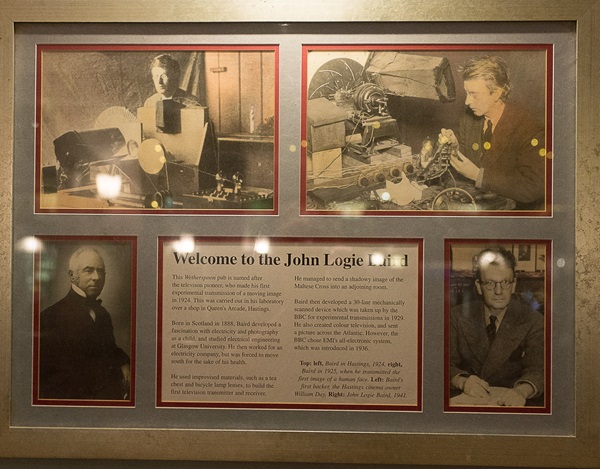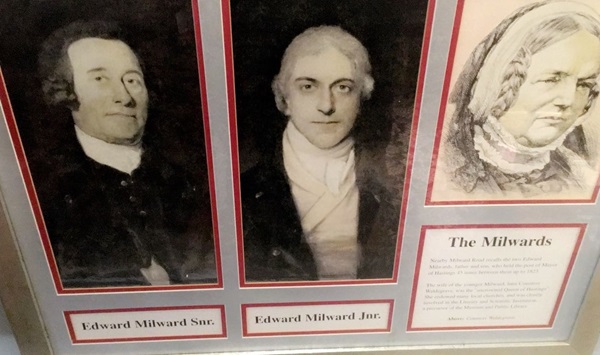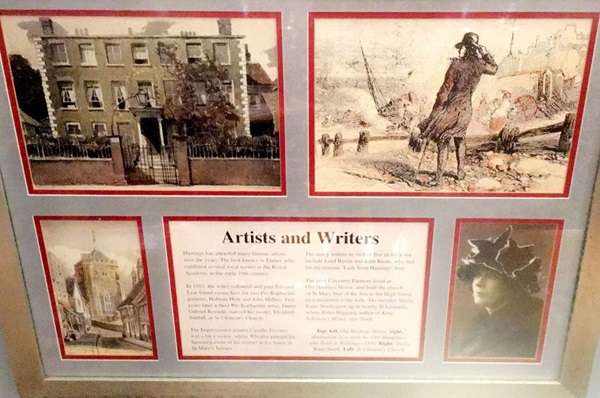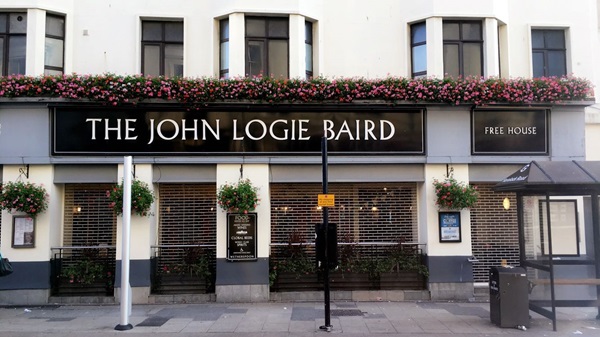John Logie Baird first conceived his extraordinary idea of television while out walking among the hills above Hastings. His early experiments took place in the town, and the first pictures were transmitted in his Queens Parade workshop in 1924. The building is now marked by a commemorative plaque.
Photographs and text about The John Logie Baird.

The text reads: This Wetherspoon pub is named after the television pioneer, who made his first experimental transmission of a moving image in 1924. This was carried out in his laboratory over a shop in Queen’s Arcade, Hastings.
Born in Scotland in 1888, Baird developed a fascination with electricity and photography as a child, and studied electrical engineering at Glasgow University. He then worked for an electricity company, but was forced to move south for the sake of his health.
He used improvised materials, such as a tea chest and bicycle lamp lenses, to build the first television transmitter and receiver.
He managed to send a shadowy image of the Maltese Cross into an adjoining room.
Baird then developed a 30-line mechanically scanned device which was taken up by the BBC for experimental transmissions in 1929. He also created colour television, and sent a picture across the Atlantic. However, the BBC chose EMI’s all-electronic system, which was introduced in 1936.
Top: left, Baird in Hastings, 1924, right, Baird in 1925, when he transmitted the first image of a human face
Left: Baird’s first backer, the Hasting’s cinema owner William Day
Right: John Logie Baird, 1941
Prints and text about the Milwards.

The text reads: Nearby Milward Road recalls the two Edward Milwards, father and son, who held the post of Mayor of Hastings 45 times between them up to 1825.
The wife of the younger Milward, later Countess Waldegrave, was the “uncrowned Queen of Hastings”. She endowed many local churches, and was closely involved in the Literary and Scientific Institution, a precursor of the Museum and Public Library.
Above: Countess Waldegrave.
Prints and text about local artists and writers.

The text reads: Hastings has attracted many famous artists over the years. The best-known is Turner, who exhibited several local scenes at the Royal Academy in the early 19th century.
In 1852, the water-colourist and poet Edward Lear found rooms here for two Pre-Raphaelite painters, Holman Hunt and John Millais. Two years later a third Pre-Raphaelite artist, Dante Gabriel Rossetti married his model, Elizabeth Siddall, at St Clement’s Church.
The impressionist painter Camille Pissarro was a later visitor whilst Whistler painted his famous portrait of his mother in her house in St Mary’s Terrace.
The many writers to visit in the town include Lord Byron and John Keats, who met his mysterious “Lady from Hastings” here.
The poet Coventry Patmore lived at Old Hastings House, and built the church of St Mary Star of the Sea in the High Street as a memorial to his wife. The novelist Sheila Kaye-Smith grew up in nearby St Leonards, where Rider Haggard, author of King Solomon’s Mines, also lived.
Top: left, Old Hastings House, right, illustration to a story by Old Humphrey, who lived in Hastings c1850
Right: Shelia Kaye-Smith
Left: St Clement’s Church.
External photograph of the building – main entrance.

If you have information on the history of this pub, then we’d like you to share it with us. Please e-mail all information to: pubhistories@jdwetherspoon.co.uk